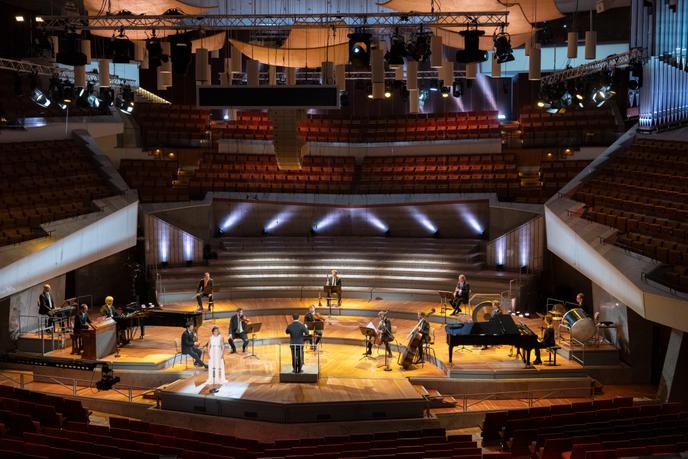Southbank Centre warns it may have to stay closed until spring 2021
The UK’s largest arts and cultural organisation, the Southbank Centre, has warned that it will have used up its financial reserves by September, forcing its closure until April 2021 unless it gets further government support.
The centre, which puts on more than 3,500 events every year and is home to eight orchestras, revealed details of the crippling financial pressures it is facing as a result of the coronavirus crisis. It said it was forecasting a best-case scenario of a £5m loss by the end of the 2020/21 financial year. In getting there, it will have used up all its reserves, taken £4m from the government’s furlough scheme, and spent its £19.2m annual grant from Arts Council England “to effectively mothball the buildings”.
The centre said: “There will be hardly any artistic activity throughout 2020/21, as to present anything like a normal range of events would have seen the losses rise to around £11m.” The venue would be able to host events with only a limited number of guests because of the restrictions necessitated by physical distancing.

Grütters: ARD-Kulturangebot kommt als Signal zum richtigen Zeitpunkt
Die geplante Gründung eines gemeinsamen Kulturangebots fast aller ARD-Sender kommt in der Corona-Krise nach Ansicht von Kulturstaatsministerin Monika Grütters (CDU) als Signal zum richtigen Zeitpunkt. «Die Kultur ist sowohl ein wichtiger Beschäftigungsfaktor als auch von enormer gesellschaftlicher Bedeutung», sagte Grütters der Deutschen Presse-Agentur.
«Die ARD und ihre Sender können hier ihr Verantwortungsbewusstsein einmal mehr unter Beweis stellen. »Ein gemeinsames Kulturangebot war schon länger im Gespräch gewesen. Am Mittwoch einigten sich die Intendanten der ARD-Anstalten auf eine gemeinsame Einrichtung mit Sitz im Sendegebiet des Mitteldeutschen Rundfunks (MDR). Allerdings macht der Bayerische Rundfunk (BR) als einzige ARD-Anstalt nicht mit. Als digitales Angebot angelegt sollen Konzerte, Ausstellungen und Kulturerlebnisse aus den einzelnen Sendegebieten gebündelt werden. Ziel ist es, die Inhalte besser auffindbar und zugänglich zu machen. Auch eine Zusammenarbeit mit den anderen öffentlich-rechtlichen Sendern ZDF und Deutschlandradio ist nach ARD-Angaben vereinbart.

Grütters: ARD cultural programme comes as a signal at the right time
The planned establishment of a joint cultural programme of almost all ARD channels comes at the right time in the Corona crisis as a signal, according to Minister of State for Culture Monika Grütters (CDU). “Culture is both an important employment factor and of enormous social importance,” Grütters told the German Press Agency.
“ARD and its stations can once again demonstrate their sense of responsibility here.” A joint cultural offering had been under discussion for some time. On Wednesday, the directors of the ARD institutions agreed on a joint facility based in the broadcasting area of the Mitteldeutscher Rundfunk (MDR). However, Bayerischer Rundfunk (BR) is the only ARD station not participating. Concerts, exhibitions and cultural experiences from the individual broadcasting areas are to be bundled together as a digital programme. The aim is to make the content easier to find and access. According to ARD, a cooperation with the other public broadcasters ZDF and Deutschlandradio has also been agreed upon.
Les orchestres contraints à jouer en chambre
Confinés en fosse ou sur un plateau, les musiciens sont au cœur des problématiques sanitaires liées à la pandémie. Parmi les recommandations sanitaires formulées par le ministère de la culture à l’endroit du spectacle vivant, rien sur la question, pourtant cruciale, des orchestres symphoniques. Un mode de fonctionnement qui liste pourtant tous les dangers. Les musiciens jouent en effet dans un espace circonscrit, voire exigu – ainsi la fosse d’orchestre invisible du Festspielhaus de Bayreuth, aussi célèbre pour son acoustique que pour l’inconfort des instrumentistes confinés sous la scène. Leur nombre, souvent pléthorique, tourne la plupart du temps autour de 90 exécutants. Il peut atteindre le millier quand s’y ajoutent, par exemple, les chœurs de la Huitième Symphonie de Gustav Mahler, dite « Symphonie des Mille ». C’est dire si l’application des gestes barrières et autres préconisations sanitaires constituent un casse-tête.

Orchestras could be forced to play in chambers
Confined in a pit or on a stage, the musicians are at the heart of the health problems linked to the pandemic. Among the health recommendations made by the Ministry of Culture for the performing arts, nothing on the crucial issue of symphony orchestras. A mode of operation that nevertheless lists all the dangers. The musicians play in a confined, even cramped space – the invisible orchestra pit at the Bayreuth Festspielhaus, which is as famous for its acoustics as it is for the discomfort of the instrumentalists confined under the stage. The number of performers, often overwhelming, is usually around 90. It can reach a thousand when, for example, the choirs of Gustav Mahler’s Eighth Symphony, known as the “Symphony of a Thousand”, are added. This means that the application of barrier gestures and other health recommendations are a headache.
 BACK
BACK